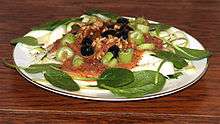Raw veganism
.jpg)
Raw veganism is a diet that combines the concepts of veganism and raw foodism. It excludes all food and products of animal origin, any food that is processed or altered from its natural state, and food cooked at a temperature above 48 °C (118 °F). Little is known about the raw vegan diet as it is not widely used. [1][2]
Motivations

In addition to the ethics of eating meat, dairy, eggs and honey, raw vegans may be motivated by health, spiritual, financial, or environmental reasons, or any combination of these.
In terms of health, some raw vegans hold the belief that cooking foods destroys the complex balance of micronutrients. They may also believe that, in the cooking process, dangerous chemicals are produced by the heat interaction with fat, protein, and carbohydrates such as advanced glycation end-products (AGEs)[3] and others.[4]
Forest gardening is a radical raw vegan lifestyle with a number of motives. For example, it can be viewed as a way to recreate the Garden of Eden.[5] Developed by raw vegan Robert Hart, forest gardening is a food production system based on woodland ecosystems, incorporating fruit and nut trees, shrubs, herbs, vines and perennial vegetables.[6] The three main products from a forest garden are fruit, nuts and green leafy vegetables.[7] Forest gardens are probably the world's oldest and most resilient agroecosystem.[8]
Nutritional considerations
Raw vegans must ensure that their intake of vitamin B12 is adequate, since it does not occur in raw plant foods.[9][10] To obtain vitamin B12, vegans require foods fortified with B12 or use dietary supplements.[11]
Research
Medical studies on raw food diets have shown some positive and negative health outcomes.[12]
A 2004 study in Washington State conducted by Luigi Fontana et al. has shown that raw vegans have a low body mass index (BMI) and a low total body fat content.[13] The low BMI and fat content is due to a low calorie and low protein diet.[14]
See also
References
- ↑ "Are enzymes really the life force in raw foods?". www.beyondveg.com. Retrieved 2016-02-12.
- ↑ Fontana, Luigi; Shew, Jennifer L.; Holloszy, John O.; Villareal, Dennis T. (2005-03-28). "Low Bone Mass in Subjects on a Long-term Raw Vegetarian Diet". Archives of Internal Medicine. 165 (6): 684. doi:10.1001/archinte.165.6.684. ISSN 0003-9926.
- ↑ Uribarri, Jaime; Cai, Weijing; Peppa, Melpomeni; Goodman, Susan; Ferrucci, Luigi; Striker, Gary; Vlassara, Helen (1 April 2007), "Circulating Glycotoxins and Dietary Advanced Glycation Endproducts: Two Links to Inflammatory Response, Oxidative Stress, and Aging", The Journals of Gerontology Series A: Biological Sciences and Medical Sciences, Oxford Journals, 62 (4): 427–433, doi:10.1093/gerona/62.4.427, PMC 2645629, PMID 17452738, retrieved 17 September 2013
- ↑ "What Does it Mean to be FullyRaw". FullyRaw. Retrieved 23 September 2017.
- ↑ Graham Bell (2004). The Permaculture Garden, p.129, "The Forest Garden…This is the original garden of Eden. It could be your garden too.
- Also see:
- Rob Hopkins (foreword), Martin Crawford (2010). Creating a Forest Garden: Working with Nature to Grow Edible Crops, p.10 "Perhaps what Hart created was the closest to what we imagine the Garden of Eden as being."
- Helmut Lieth (1989). Tropical Rain Forest Ecosystems: Biogeographical and Ecological Studies, p.611 "Important food plants, such as sago-producing palms, fruit-producing trees and medicinal plants were purposefully aggregated and tended in convenient places. Eventually, the forest garden, a kind of Garden of Eden, emerged. These jungle gardens on good soils of easy access required little maintenance and hardly any hard work."
- Dave Jacke and Eric Toensmeier (2005). Edible Forest Gardens - Volume One, p.1
- Robert Hart (1996). Forest Gardening: Cultivating and Edible Landscape, p.80
- ↑ Robert Hart (1996). Forest Gardening.
- ↑ Patrick Whitefield (2002). How to Make a Forest Garden. p. 5.
- ↑ Douglas John McConnell (2003). The Forest Farms of Kandy: And Other Gardens of Complete Design. p. 1.
- ↑ "Vitamin B12: your key facts". Vegan Society. Archived from the original on 2007-02-20. Retrieved 19 May 2016.
Vitamin B12, whether in supplements, fortified foods, or animal products, comes from micro-organisms.
- ↑ Rizzo G, Laganà AS, Rapisarda AM, La Ferrera GM, Buscema M, Rossetti P, Nigro A, Muscia V, Valenti G, Sapia F, Sarpietro G, Zigarelli M, Vitale SG (2016). "Vitamin B12 among Vegetarians: Status, Assessment and Supplementation". Nutrients. 8 (12). doi:10.3390/nu8120767. PMC 5188422. PMID 27916823.
- ↑ "Healthy choices on a vegan diet". Vegan Society. Archived from the original on 2007-02-05. Retrieved 2007-02-14.
- ↑ Cunningham, Eleese (2004). "What is a raw foods diet and are there any risks or benefits associated with it?". Journal of the American Dietetic Association. 104 (10): 1623. doi:10.1016/j.jada.2004.08.016. PMID 15389429.
- ↑ Mariotti, François (2017-05-23). Vegetarian and Plant-Based Diets in Health and Disease Prevention. Academic Press. p. 802. ISBN 9780128039694.
- ↑ Fontana, Luigi; Shew, Jennifer L.; Holloszy, John O.; Villareal, Dennis T. (2005-03-28). "Low Bone Mass in Subjects on a Long-term Raw Vegetarian Diet". Archives of Internal Medicine. 165 (6): 684. doi:10.1001/archinte.165.6.684. ISSN 0003-9926.
